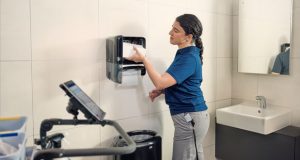As the lockdown loosens, many businesses are preparing to reopen their workplaces. But with the threat of COVID-19 still casting its shadow over our health, Chris Wakefield, Vice President, European Marketing & Product Development at GOJO Industries-Europe, says we must work hard to ensure people don’t become complacent about hand washing or sanitising.
From helping safeguard against staff absenteeism, to enhancing the image of an organisation, cleanliness and hygiene have always played a significant role in commercial success. Today, as we continue to battle against coronavirus, its importance has been put firmly under the spotlight, especially when it comes to hand hygiene.
COVID-19 has reworked behavioural norms on a mass scale. Pre-pandemic, studies revealed that hand hygiene wasn’t practised effectively, for long enough, or, in some cases, at all. However, 2020 has seen best practice increase phenomenally, and it is vital that this newfound healthy attitude to hand washing and sanitising continues, particularly as lockdown eases and companies reopen for business.
It is essential that people do not slip back into bad habits, because hand hygiene is one of the most powerful weapons we have to protect ourselves, and others, from this terrible disease. Hundreds of studies have proven that this simple act can break the chain of infection, and prevent the spread of harmful germs and bacteria.
So what measures can businesses put in place to achieve maximum compliance and ensure their workplace is as healthy and hygienic as possible?
Healthy hands
The first step in positively influencing good hand hygiene behaviour is to ensure that the products are a pleasure to use. With so many people considering themselves to have sensitive skin(1), soaps must be both effective against germs and gentle to skin. Businesses should therefore opt for mild formulations that won’t irritate but have proven efficacy.
They might also consider supplying hand cream to use afterwards, as repeated exposure to water can dry out skin. Using moisturisers can combat this, helping to rehydrate and replenish oils in the skin, and prevent dry, damaged hands.
The right technique
Hands should be washed for 20 seconds, using one single measure of soap. With COVID-19 lurking in people’s awareness, there has been a rise in people overusing soap, which in turn wastes product and costs businesses money. One dose of product is enough for an effective clean. Once the soap is lathered, it should be rubbed all over both front and backs of hands, and in between fingers and thumbs. After washing, hands should be rinsed and dried thoroughly.
There is a wealth of information from respected sources, including the NHS, illustrating how best to practise hand hygiene. Employers should seek to place such posters at hand washing facilities, because visual aids not only educate, they also act as highly effective prompts.
Hidden touchpoints
There are many instances where hands will need to be washed or sanitised, most obviously, in the washroom and kitchen. Many responsible employers are also implementing hand sanitising stations in other shared environments, such as reception areas, meeting rooms, and at the main entrance and exits to the building.
As well as in these busy areas, staff should be encouraged to think about other, not so obvious, high touchpoints. There are many hidden dangers in workplaces, and even the most diligent may not realise just how many common objects become havens for harmful bacteria. For example, the handle on the office kettle, the keypad entry system, or even a pen left on a desk may harbour bacteria, transferred by a previous user.
We have a shared responsibility to continue practising good hand hygiene. As the lockdown loosens, it’s important that people’s attitudes to hand washing and sanitising don’t do the same. Practising hygienic behaviour will help businesses achieve healthier workspaces, and in turn protect their workforce from succumbing to many harmful germs and viruses, such as seasonal flu, norovirus, common coughs and colds, and of course, coronavirus.
(1) 60–70% of women and 50–60% of men report having sensitive skin to some degree (https://www.ncbi.nlm.nih.gov/pmc/articles/PMC6533878/)





